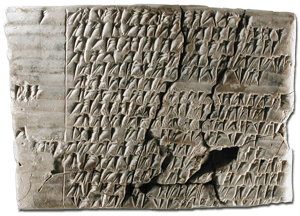Archaeology Magazine
Volume 65 Number 1, January/February 2012
by Andrew Lawler
The rush to document thousands of ancient texts before they are sent back to Iran, or sold, reveals the daily workings of the Persian Empire
Tens of thousands of clay tablets and fragments from Persepolis are written in cuneiform to express Elamite, an ancient language of western Iran.
(Courtesy Persepolis Fortification Archive Project, Oriental Institute)
Tensions between Iran and the United States have rarely run higher, with both governments sparring over alleged terror plots, disputing the nature of Iran’s nuclear program, and vying to influence the uprisings across the Arab world. But in Chicago and Boston courtrooms, the two countries have found rare common ground—neither wants ancient tablets from the royal palace of Persepolis in Iran to end up on the auction block. To the relief of scholars, two recent court rulings may give them their joint wish, preserving open access to what is the most significant source of information on the ancient Persian Empire uncovered to date.
In the early 1930s, during excavations of Persepolis, University of Chicago archaeologist Ernst Herzfeld unearthed tens of thousands of fragments of fragile clay tablets dating from about 500 B.C. The fragments were packed into 2,353 cardboard boxes and shipped to the university’s Oriental Institute. The Iranian government of the day allowed the export, with the understanding that the tablets would be translated and then returned. But the task of piecing together and understanding the vast number of fragments has been under way for more than seven decades and the majority of the collection remains in Chicago. Now, fearing loss of the archive, the university has moved into high gear to create thousands of digital images of the tablets, which record the day-to-day accounts of the empire during the reign of Darius the Great (521–486 B.C.) and include records of those traveling on behalf of the king, lists of workers’ rations, and careful notation of offerings made to deities.
Researchers hope to have most of this intensive effort completed within the next two years. To get the job done, the institute has assembled what Gil Stein, director of the Oriental Institute, calls a “dream team” of textual scholars, archaeologists, and technical experts in digital cataloguing to take images of the tablets and make them available for public use. Translations are also being done, though it will take much longer to complete that daunting task. “Whether they are seized for sale or the government of Iran demands them back, the tablets will be out of the building soon. We all understand how important and urgent this is,” says Stein.
To read more, find ARCHAEOLOGY in your local newsstand or bookstore, or click here to buy a copy of the issue online. And if you'd like to receive ARCHAEOLOGY in your mailbox, click here to subscribe.
Andrew Lawler is a contributing editor at ARCHAEOLOGY.



